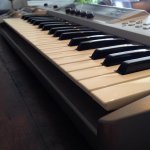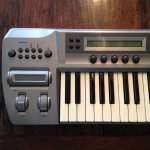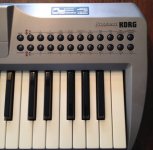Hierbij bied ik mijn korg prophecy te koop aan. Ik doe er te weinig mee. Er zit een mooie harde flight case bij.
Zomer opruiming, vaste prijs is 250 euro inclusief de flightcase. Alleen ophalen in Breda!
The Korg Prophecy is considered one of the earliest (mid-nineties) "virtual analog" (a.k.a. VA) synthesizers, although its synthesis capabilities went beyond many of its VA contemporaries.
Along with the Korg Trinity, this little synth is a direct ancestor of the ill-fated OASYS project[citation needed]. It was a small 3-octave monosynth, a pioneer of the late 1990s "return-to-analog" trend. Offering assignable knobs, a "log controller" (a mix-up of a modulation wheel and ribbon controller assembled like a "sausage") and many other control sources, it invited players to tweak and shape the sound both easily and quickly. Deep editing, however, wasn't as straightforward, because the sound engine contained no less than 13 DSP-modeled oscillator types, each one offering a large number of parameters to adjust. Some of the most used DSP models were the analog model (based on the classic osc+filter+amp scheme, although with many powerful enhancements), the VPM model (some sort of FM synthesis which cleverly avoided Yamaha's FM patent) and the "physical modeling" algorithms. The latter deserves special mention. In the mid to late 1990s, it was believed that digital "physical modeling", which recreated the sound of acoustic instruments (brass, strings, woodwinds, etc.) using DSP algorithms instead of samples, would eventually replace sample-based synthesis of those instruments, because of its unprecedented realism and expressiveness. As time passed, physical modeling seemed to lose its appeal to both manufacturers (because of the cost of investigation and implementation) and final users, who complained about the realism of the models and limited polyphony. Also, more complex playing techniques were required to play the models in a convincing way. Nevertheless, the Prophecy's low cost and broad implementation of sound generation techniques earned it a significant place in synthesizer history.
Technically, the Prophecy offered one-note monophony, several effects (including distortion, wave shaping, delay/reverb and chorus/flanger), and 128 memory locations for user sound programs. No disk drive or sequencer was included, but its integrated arpeggiator was a source of "instant gratification", as some magazines put it. Standard MIDI features and a pair of audio outputs were also offered.
Zomer opruiming, vaste prijs is 250 euro inclusief de flightcase. Alleen ophalen in Breda!
The Korg Prophecy is considered one of the earliest (mid-nineties) "virtual analog" (a.k.a. VA) synthesizers, although its synthesis capabilities went beyond many of its VA contemporaries.
Along with the Korg Trinity, this little synth is a direct ancestor of the ill-fated OASYS project[citation needed]. It was a small 3-octave monosynth, a pioneer of the late 1990s "return-to-analog" trend. Offering assignable knobs, a "log controller" (a mix-up of a modulation wheel and ribbon controller assembled like a "sausage") and many other control sources, it invited players to tweak and shape the sound both easily and quickly. Deep editing, however, wasn't as straightforward, because the sound engine contained no less than 13 DSP-modeled oscillator types, each one offering a large number of parameters to adjust. Some of the most used DSP models were the analog model (based on the classic osc+filter+amp scheme, although with many powerful enhancements), the VPM model (some sort of FM synthesis which cleverly avoided Yamaha's FM patent) and the "physical modeling" algorithms. The latter deserves special mention. In the mid to late 1990s, it was believed that digital "physical modeling", which recreated the sound of acoustic instruments (brass, strings, woodwinds, etc.) using DSP algorithms instead of samples, would eventually replace sample-based synthesis of those instruments, because of its unprecedented realism and expressiveness. As time passed, physical modeling seemed to lose its appeal to both manufacturers (because of the cost of investigation and implementation) and final users, who complained about the realism of the models and limited polyphony. Also, more complex playing techniques were required to play the models in a convincing way. Nevertheless, the Prophecy's low cost and broad implementation of sound generation techniques earned it a significant place in synthesizer history.
Technically, the Prophecy offered one-note monophony, several effects (including distortion, wave shaping, delay/reverb and chorus/flanger), and 128 memory locations for user sound programs. No disk drive or sequencer was included, but its integrated arpeggiator was a source of "instant gratification", as some magazines put it. Standard MIDI features and a pair of audio outputs were also offered.


